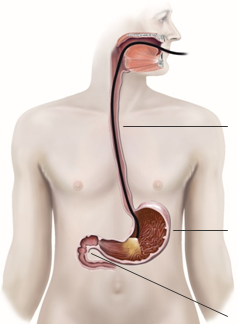Gastroscopy (Upper GI Endoscopy) at The Holly Hospital
Or call us on
A gastroscopy is a procedure to look at the inside of the oesophagus (gullet), stomach and duodenum using a flexible telescope.
What is Gastroscopy (OGD)?

Also known as Upper gastrointestinal (GI) endoscopy or OesophagoGastroDuodenoscopy, a gastroscopy is a procedure to look at the inside of the oesophagus (gullet), stomach and duodenum using a flexible endoscope (camera).
What are the benefits of a gastroscopy?
A gastroscopy can help to explore possible causes of:
- Feeling sick
- Vomiting
- Abdominal pain
- Difficulty swallowing
- Bloating
- Diarrhoea
- Unexplained weight loss
- Anaemia
Preparing for gastroscopy
Do not eat anything or take medications in the 6 hours before your appointment. You can continue to drink small sips of water until 2 hours before the procedure.
What happens during a gastroscopy?
A gastroscopy usually takes about 10 minutes. You will be asked to remove any false teeth or plates. The endoscopist will spray a local anaesthetic at the back of your throat to numb it. This can taste unpleasant but helps to make you comfortable. You will be asked to lie on your left side and a small mouth guard will be placed between your teeth to protect them and keep your mouth open.
The healthcare team will monitor your oxygen levels and heart rate using a finger or ear clip and if needed, may give you oxygen through a small tube under your nostrils. You may be given a sedative and pain relief through a cannula that may be put in your arm or back of the hand. This will help you feel comfortable and reduce the chance of you experiencing severe pain or discomfort. You may also receive Buscopan to relax your muscles.
Your consultant will place a flexible tube called an endoscope into the back of your throat and down into your stomach. You may be asked to swallow to help guide the tube. From here the endoscope will pass on into your duodenum. The endoscope will not interfere with your breathing but initially, you may experience a retching sensation. If you have a lot of saliva, suction may be used. You may feel some discomfort and your stomach may feel bloated because air is blown into it to help the endoscopist have a clear view. They will be able to look for problems in these organs such as inflammation or ulcers.
Your consultant will also be able to perform biopsies and take photographs to help make the diagnosis. When the examination is complete your consultant will gently remove the endoscope.
If at any time you want the procedure to stop, raise your hand and your endoscopist will end the procedure as soon as it is safe to do so.
What happens after the procedure?
When the local anaesthetic in the back of your throat wears off you can drink and eat normally. You may develop a sore throat or dry mouth and slight hoarseness, following the procedure. Throat lozenges and saltwater gargles can ease these symptoms. You may feel a bit bloated for a few hours but this will pass.
If you were not given a sedative, you should be able to go home after a member of the team has spoken to you and decided that you’re ready. You can resume with your activities as normal.
If you were given a sedative, you will normally recover in about an hour. You should have a responsible adult take you home by car or taxi and to stay with you at least 24 hours. You should also not drive, drink alcohol, sign any legal documents, operate machinery or do any potentially dangerous activities (this includes cooking) for at least 24 hours, and not until you have fully recovered feeling, movement and co-ordination.
The healthcare team will tell you what was found during the endoscopy and will discuss with you any treatment or follow-up you need. You will be given a copy of your endoscopy report and a discharge advice sheet. Results from the biopsies will not be available until a later date and will be discussed during your follow-up consultation. You should be able to go back to work the day after the endoscopy. Most people make a good recovery and return to normal activities following a gastroscopy.
Gastroscopy Information leaflets:
Gastroscopy with Bravo pH capsule
Gastroscopy with Oesophageal Stent
Gastroscopy aftercare advice (with sedation)
Gastroscopy aftercare advice (without sedation)
Therapeutic gastroscopy procedures offered:
Bravo pH Capsule, Upper GI Dilatation, Insertion of Oesophageal or Duodenal Metal Stent, Banding of Oesophageal Varices, Argon Plasma Coagulation and Botox injection.
If you would like to book a consultation regarding Upper GI Endoscopy please call us on 020 8505 3311 or fill out the form below.
Gastroscopy (or gastrointestinal (GI) endoscopy) consultants at The Holly Hospital
High Road, Buckhurst Hill, Essex, IG9 5HX
Our car park operates a Pay and Display system.
Ways to pay
Nuffield Health promise
Our prices are all-inclusive. We will equal any comparable price. There are no time limits on your aftercare.
Paying for yourself
There are no hidden costs in our treatment prices. The price you see is the price you pay.
Find out morePersonal medical loan
Spread the cost of your treatment with a 6, 10 or 12 month 0% personal medical loan.
Find out moreMedical insurance
We work with you and your insurance provider to get you the treatment you need quickly
Find out more







